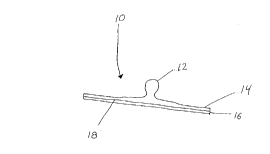Note: Claims are shown in the official language in which they were submitted.
- 8 -
What is Claimed:
1. An integral, conductive electrode comprising:
a stud adapted to detachably couple the electrode to a lead wire; and
a body integral with said stud, said body having a face disposed
opposite said stud adapted to contact a patient, said face having a grooved pattern
formed therein.
2. The integral, conductive electrode of claim 1, wherein said stud and
said body are made from conductive plastic.
3. The integral, conductive electrode of claim 2, wherein said
conductive plastic is carbon-filled plastic.
4. The integral, conductive electrode of claim 3, wherein said
carbon-filled plastic is radiolucent.
5. The integral, conductive electrode of claim 3, wherein said plastic is
selected from the group consisting of polyurethane, polyethylene, and
acrylonitrile-butadiene-styrene.
6. The integral, conductive electrode of claim 1, wherein said body
includes a flat, thin, pliable region adapted to conform to the contours of the patient.
7. The integral, conductive electrode of claim 1, wherein said stud has a
first radius and said body has a second radius significantly greater than the first radius.
8. The integral, conductive electrode of claim 1, wherein said electrode
is devoid of any silver/silver chloride coating.
9. The integral, conductive electrode of claim 1, further comprising a
conductive, pressure-sensitive adhesive coated on said face.
10. The integral, conductive electrode of claim 1, further comprising a
conductive gel coated on said face.
11. The integral, conductive electrode of claim 10, wherein said gel is
adhesive.
12. The integral, conductive electrode of claim 1, wherein said stud
includes a hollow providing material relief.
13. A two-piece, conductive electrode comprising:
- 9 -
an electrically conductive stud adapted to detachably couple the
electrode to a lead wire; and
an electrically conductive body having an opening formed therein and
attached to said stud, said stud overlapping said opening formed in said body, said
body having a face disposed opposite said stud adapted to contact a patient, said face
having a grooved pattern formed therein.
14. The two-piece, conductive electrode of claim 13, wherein said stud
and said body are made from conductive plastic.
15. The two-piece, conductive electrode of claim 14, wherein said
conductive plastic is carbon-filled plastic.
16. The two-piece, conductive electrode of claim 15, wherein said
carbon-filled plastic is radiolucent.
17. The two-piece, conductive electrode of claim 15, wherein said
plastic is selected from the group consisting of polyurethane, polyethylene, andacrylonitrile-butadiene-styrene.
18. The two-piece, conductive electrode of claim 13, wherein said body
includes a flat, thin, pliable region adapted to conform to the contours of the patient.
19. The two-piece, conductive electrode of claim 13, wherein said stud
has a first dimension and said body has a second dimension significantly greater than
the first dimension.
20. The two-piece, conductive electrode of claim 13, wherein said
electrode is devoid of any silver/silver chloride coating.
21. The two-piece, conductive electrode of claim 13, further
comprising a conductive, pressure-sensitive adhesive on said face.
22. The two-piece, conductive electrode of claim 13, further
comprising a conductive gel on said face.
23. The two-piece, conductive electrode of claim 22, wherein said gel
is adhesive.
24. The two-piece, conductive electrode of claim 13, wherein said stud
includes a hollow providing material relief.
25. A conductive electrode comprising:
- 10-
an electrically conductive body having a face adapted to contact a
patient, said face having a grooved pattern formed therein; and
a lead wire welded to said body.
26. The conductive electrode of claim 25, wherein said body is made
from conductive plastic.
27. The conductive electrode of claim 26, wherein said conductive
plastic is carbon-filled plastic.
28. The conductive electrode of claim 27, wherein said carbon-filled
plastic is radiolucent.
29. The conductive electrode of claim 27, wherein said plastic is
selected from the group consisting of polyurethane, polyethylene, and
acrylonitrile-butadiene-styrene.
30. The conductive electrode of claim 25, wherein said body includes a
thin, pliable region adapted to conform to the contours of a patient.
31. The conductive electrode of claim 25, wherein said electrode is
devoid of any silver/silver chloride coating.
32. The conductive electrode of claim 25, further comprising a
conductive, pressure-sensitive adhesive coated on said face.
33. The conductive electrode of claim 25, further comprising a
conductive gel coated on said face.
34. The conductive electrode of claim 33, wherein said gel is adhesive.
35. A method of manufacturing an integral, conductive electrode, the
method comprising:
providing a mold including a stud cavity and a body cavity, the body
cavity having a face corresponding to a portion of the electrode adapted to contact a
patient, said face having a grooved pattern formed therein;
injecting liquefied, conductive plastic into said mold; and
allowing the liquefied, conductive plastic to solidify.
36. An electrode comprising:
a contact portion adapted to couple the electrode to a lead wire; and
- 11 -
a body adjacent to said contact portion, said body having a face
disposed opposite said contact portion and adapted to contact a patient, said face
having a grooved pattern formed therein.
